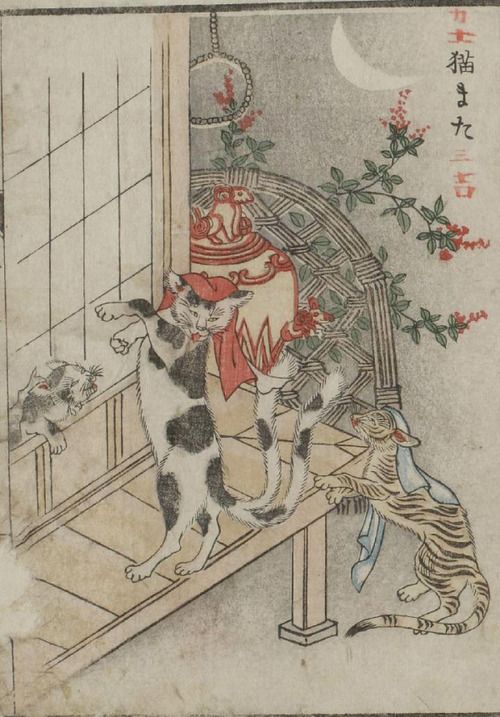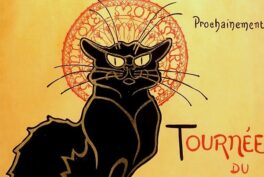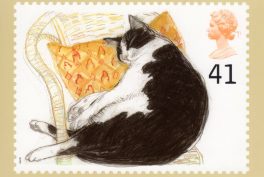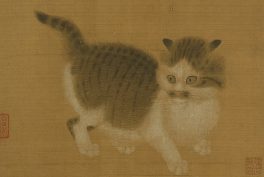Summary
- Initially, cats were treated in Japan as exotic, indoor pets. In the Edo period, they became an important benefit for agriculture, due their ability to hunt rodents.
- As indoor pets and because of their association with traditional housework, cats started being linked with women.
- In The Tale of Genji, the cat had a fundamental impact on the story of the character named the Third Princess, which led to further associations between cats and women.
- The popularity of The Tale of Genji inspired numerous, often eroticized, prints with women and cats in Japanese art.
- Kaibyō were giant cats, which appeared in ghost and horror stories.
- Bakeneko were monstrous cats featured in kabuki theatre and ukiyo-e, often serving as the background.
- Bakeneko often possessed aristocratic childless widows, who were seen as living the closest to the “otherworld.”
- The violence caused by bakeneko reflected society’s fears towards childless women, as well as women’s indignation over their social position.
- Since cats were especially associated with magic, it was believed with age that they grew a forked tail and became humanoid, which was often depicted in art.
- Anthropomorphic cats also became a way to fight censorship imposed on art by the shogunate.
- Many famous ukiyo-e artists portrayed cats simply for their cuteness.
One of the most globally well-known Japanese art forms is the ukiyo-e woodblock prints. The term ukiyo-e stands for “pictures of the floating world.” As Helen B. Chapin explains, this was originally a Buddhist phrase contemplating the transience of life. Hence, it is exactly this transience which ukiyo-e attempted to capture in print. Ukiyo-e generally depicted a wide range of natural, fantastical, historical, and mundane scenes. It thusly offers a unique insight into the daily lives and gradual changes taking place within the Japanese society of the 17th to the 19th centuries. One of the many actors featured regularly within ukiyo-e are cats.
Cats in Japan
Unlike many other global societies, who had been employing cats as agents of pest control since as early as the Neolithic period (10,000 BCE-2,000 BCE) in the Fertile Crescent, cats only arrived in Japan in the early Heian period (794-1185) through trade with China. As Darya N. Belova and Grace Kim summarized, due to their comparatively late arrival in Japan, cats were initially introduced as exotic pets and kept on leashes for the Japanese upper class. Only during the Edo period (1603-1868), cats became more widespread throughout different classes in Japanese society, and became, once again, central agents of pest control.
This was especially beneficial for Japanese agriculture and even the Japanese production of silk, since cats were able to significantly reduce the consumption of seed or silkworms by rodents. Due to their extensive successes in specifically increasing and enhancing Japanese silk production, cats soon became a symbol of successful silk production. This was, subsequently, featured prominently within ukiyo-e prints.
Cat Catching Mouse by Ohara Koson (1877-1945) is one of the many popular examples of ukiyo-e prints depicting cats within their professional capacity of catching mice.

Ohara Koson, Cat Catching Mouse, 1930, private collection.
Cats and Women
Shared Profession, Shared Company
In Edo period Japan, silk production was primarily associated with what were considered women’s responsibilities of weaving. Hence, as Grace Kim argued, cats’ increasing importance in Japanese silk production, likewise, encouraged a distinctive association between cats and women from all classes engaged in what was considered traditional housework. As Kim highlighted, this association predates the wider distribution of cats within Japanese society.
As Kim portrays, already in the Heian period (794-1185), cats were associated specifically with aristocratic women for two reasons. Firstly, Japanese aristocratic women during this period mostly remained within inner living quarters, unlike Japanese men who conducted most of their business outside. Since cats were still considered exotic pets that were kept inside, aristocratic women were simply the population group who shared the most time with cats.
The Heian period significantly predates the emergence of ukiyo-e art. However, one example of this close association in ukiyo-e is The Third Princess and Her Cat, a retrospective historical portrayal of a Heian aristocratic woman playing with a cat by Ishikawa Toyonobu (1711-1785). Despite being created about 400 years after the end of the Heian period this print does feature the traditional aristocratic Heian female hairstyle, clothes, and cat leash.

Ishikawa Toyonobu, The Third Princess and Her Cat, 1740s, Museum of Fine Arts Boston, Boston, MA, USA.
The Tale of Genji: Initial Encounter
Secondly, Grace Kim emphasizes the association between aristocratic women and cats in Japan was fundamentally defined by the literary work The Tale of Genji. It was one of the most important literary works of the period, considered a necessary read for all members of the Japanese aristocracy from the Heian period onwards. As Kim illustrated, The Tale of Genji both reflected and defined the association between aristocratic women and cats in a scene in chapter 34 titled Spring Shoots I.
The scene prominently features an aristocratic female character named the Third Princess who is married to the main character Hikaru Genji. The Third Princess is accidentally seen by the male character Kashiwagi as a result of her spooked pet cat destroying the bamboo blinds separating her from the outside world.
As Kim clarifies, social customs of the time dictated that aristocratic women during this period in Japan were not meant to be seen directly by any men except for their husbands. Thus, the described situation was highly uncommon and occurred only due to the cat who could overcome these social boundaries. Within The Tale of Genji, this initial encounter later escalated in the Third Princess being sexually assaulted by Kashiwagi. This, likewise, ultimately results in her fall from society.
One example of the many depictions of this scene within ukiyo-e is Parody of the Third Princess and Kashiwagi: “Chapter 50: A Hut in the Eastern Provinces,” 1858 by Utagawa Kunisada (1786-1865). Notably, Utagawa Kunisada was considered one of the most popular and commercially successful ukiyo-e artists of 19th-century Japan. Therefore, the depiction of the scene by Kunisada showcases the overall popularity of both The Tale of Genji and this scene specifically.

Utagawa Kunisada, Parody of the Third Princess and Kashiwagi: “Chapter 50: A Hut in the Eastern Provinces”, 1858, Metropolitan Museum of Art, New York City, NY, USA.
The Tale of Genji and Ukiyo-e
As Grace Kim highlights, the scene of the initial encounter underwent significant transformations. These ranged from depicting the Third Princess as an innocent victim during the Heian period to her being commonly portrayed as a proactive seductress. This change was accompanied by an overall erotization of the popular depictions of The Tale of Genji scenes and the first encounter in particular.
This is relevant to the representation of cats in Japanese art throughout the Edo period. As Kim argued, both the overall association of aristocratic women and their cats as well as the popularity of The Tale of Genji, generally inspired numerous ukiyo-e portraits of women, particularly aristocratic, with their cats. The aforementioned popularity and erotization of the initial encounter, moreover, inspired ukiyo-e portraits of varying erotic content featuring cats together with geishas, sex workers, or women who were considered to be sexually available in general.
One of the many examples of these diverse portraits of women with their cats in Japanese art is Teasing the Cat by Tsukioka Yoshitoshi (1839-1892). The image portrays the playful and gentle interaction between a woman and her cat. It is noteworthy that Tsukioka Yoshitoshi is considered one of the great creative masters of the late ukiyo-e. His work is especially well-known for its bright colors, clean lines, and diverse storytelling as demonstrated within this print.

Tsukioka Yoshitoshi, Teasing the Cat, 1888, Metropolitan Museum of Art, New York City, NY, USA.
Bakeneko
The Functions of Horror
This close association between women and cats was also reflected in the contemporary kaidan, which encompassed performances and depictions of a wide diversity of ghost and horror stories. Kaidan was, as Kim and Belova demonstrated, widely popular amongst all classes in Japan from the Edo period onwards. It functioned as an important outlet to express and process both common fears and social issues of Japanese society of the time.
The systematic vulnerability of women within the highly patriarchal Japanese society was no exception to this. Due to the close association between cats and women, these specific issues or fears related to women were frequently represented through the actions of monstrous cats also called kaibyō which translates to “strange cat.”
Kaidan frequently featured the literal expression of this close association between cats and women through kaibyō. See for example, Butterfly Dancer and Monster Cat: Kabuki by Utagawa Yoshitaki (1841-1899), where one of the female characters is in the process of literally becoming one with the monstrous cat. In the context of this print, it is noteworthy that cats were generally depicted with butterflies as a symbol for hunting and feline hunting instincts.

Utagawa Yoshitaki, Butterfly Dancer and Monster Cat: Kabuki, 1870, private collection.
Bakeneko
A specific type of kaibyō was bakeneko. Bakeneko were “changed cats” frequently featured in Japanese art, particularly kabuki theatre and ukiyo-e prints. They were, as Kim and Belova summarized, gigantic cats who drank lamp oil, could spout spheres of fire and had the ability to possess people, especially women, to perform gruesome murders.
The depictions of bakeneko within ukiyo-e frequently consist of regular portrayals of the woman who is possessed, with only the ghostly presence of the face of a wrathful cat in the background. This is, as Kim and Belova elaborate, a reference to the popular appearance of bakeneko characters in kabuki theatre where the spirit possession would be indicated through the images of the monstrous cat in the background.
One particular example of this bakeneko depiction is The Story of the Nippondaemon and the Cat by Utagawa Kuniyoshi (1797-1861). The title refers to a kabuki performance of the same title.

Utagawa Kuniyoshi, The Story of the Nippondaemon and the Cat, 1847, Museum of Fine Arts Boston, Boston, MA, USA.
The Liminality of Women
As Grace Kim has explained, the characters most commonly possessed by the bakeneko were childless aristocratic women, particularly widows. The reasons for this were threefold. Firstly, as previously outlined, women, especially aristocratic women, were already closely associated with cats in the understanding of Edo period Japanese audiences.
Secondly, aristocratic women were at the time understood to be least connected to society due to their previously mentioned isolation from interactions with individuals or businesses outside of the household. In the eyes of the public, this made them particularly close to the “otherworld”1 as opposed to the common living world and, thus, especially vulnerable to possession.
Thirdly, this vulnerability was assumed to be even further exacerbated for childless widows as they had, in the understanding of the patriarchal society, failed their primary function as women to bear a male heir. Without conforming to this traditional role, these women reside in, what Kim described as, “social liminality” at the outskirts of Japanese society of the Edo period. This made them closer to the “otherworld” and made them more susceptible to possession.
The mentioned liminality is, for instance, directly depicted in Apparition of the Monstrous Cat by Utagawa Kuniyoshi. In this print, the female host of the bakeneko is depicted in ghostly white, floating in between worlds. The scene presents the same story as the previous kabuki performance The Story of the Nippondaemon and the Cat also known as The Vampire Cat of Nabeshima.
This scene specifically portrays how the bakeneko is stealing the lifeforce of the male main character, Prince Hizen who is looking at his love interest, the female host of the bakeneko. Since the prince is already at the brim of death, his spirit is portrayed on the right next to the female host. On the left, however, we see the soldier who is about to slay the bakeneko and, thus, save the prince.

Utagawa Kuniyoshi, Apparition of the Monstrous Cat, 1847, private collection.
Fear and Rage
The possession by the bakeneko and the subsequent wrathful murder sprees portrayed two emotions. It represented, as Grace Kim highlighted, the collective fear of the patriarchal society of both the presence of these women as well as the existential fear of them obtaining power. Yet, the actions of the bakeneko uniquely reflected the agency of the women and directly acknowledged the rage they must have felt over their status of liminality within Japanese society.
One direct example of the expression of this unique connection between bakeneko and women is Okabe: The Cat Witch by Utagawa Kuniyoshi, which depicts specifically an old childless aristocratic widow possessed by a bakeneko.

Utagawa Kuniyoshi, Okabe: The Cat Witch, 1844, private collection.
Other Representations of Kaibyō
Tails of Magic
In the context of bakeneko, it is relevant to briefly review the wider appearance of kaibyō within the ukiyo-e art since not all kaibyō were directly associated with women. To start, we need to briefly talk about the prevalence of Shintō beliefs in Japan at the time. As Darya N. Belova explains, according to Shintō, all living beings who live too long become significantly closer in connection to the “otherworlds” and start to show varying degrees of magic as they age. This applied to various animal species, becoming anthropomorphic and magical with age, such as, for example, foxes, or tanuki (Japanese raccoon dogs).
Because cats were imported comparatively late into Japan, they were considered especially mysterious and closely related to magic, crossing borders between worlds. As Yonekichi Hiraiwa portrayed, these combined beliefs led to the widely established superstition, primarily during the 18th and 19th centuries, that when a cat reached a certain age, it would grow a forked tail, start walking on its hind legs, and engage in what were considered demonic activities.
This resulted in the vastly common Japanese practice of tail bobbing to avoid the cats growing a forked tail. Due to the close association between cats and the “otherworld”, various kaibyō appear in ukiyo-e. One example was the kasha who was, as Belova summarizes, a cat grown too old. Kasha had an appearance engulfed by fire and was rumored to steal corpses to either drag them to one of the “otherworlds”, eat them, or resurrect them as the undead.
Another specific example were the nekomata which, according to Kim, were forked-tailed cats who would act humanoid. They would put hand towels on their heads, dance or perform music, and cause general mayhem by summoning other monsters or committing various acts of theft.
One of the many depictions of nekomata in ukiyo-e is Nekomata by Toriyama Sekien (1712-1788). Sekien was a highly instrumental figure in the collection of Japanese tales of monstrous beings. He is most well-known for the compilation of one of the first and most famous bestiaries of Japanese supernatural beings The Illustrated Night Parade of a Hundred Demons.

Toriyama Sekien, Nekomata from The Illustrated Night Parade of a Hundred Demons, 1776.
Censorship
In connection to the anthropomorphic cats, it is relevant to note that in 1841-1843, the shogunate authorities (the military ruling class of the Edo period) temporarily applied strict censorship on art including the work of ukiyo-e artists. As Ranshanzi Xiao explains, this censorship included a ban on depicting humans, especially, famous individuals.
The new law aimed to reduce the booming entertainment culture and limit criticism of the shogunate through art. To circumvent this censorship, many ukiyo-e artists such as Utagawa Kuniyoshi, started to systematically depict highly anthropomorphic cats as direct representations of human individuals.
Two of the many examples of this are Fashionable Cats Juggling Balls by Utagawa Kuniyoshi and Life of Cats by Utagawa Yoshiiku (1833-1904).
Cats and Artists
Apart from these various associations which we already discussed, cats in ukiyo-e were also portrayed simply for their feline adorableness. As all over the world, many Japanese ukiyo-e artists were delighted by the endearing expressions and personalities of cats.
One of many examples of this is Two Cats by Hibiscus by Hokusai (1760-1849), the most globally well-known ukiyo-e artist. Other unmissable portrayals of cats in Japanese art created simply for their cuteness are Sleeping Cat by Kawanabe Kyosai (1831-1889), Tama the Cat by Takahashi Hiroaki (1871-1945), and Cat in Window by Utagawa Hiroshige (1797-1858).
As you can see, some of the most well-known examples of cats in Japanese art are from diverse portrayals by Utagawa Kuniyoshi. Cats Suggested by the Fifty-three Stations of the Tōkaidō is only one among many of his portraits of cats engaged in a wide range of mundane actions. These specific ones were based on the cats he encountered on his travels on the Tokaido road which was, at the time, the largest road in Japan and connected Kyoto and Edo alongside the coast. By the way, if you like this work, you can get it as a high-quality print in our DailyArt shop!

Utagawa Kuniyoshi, Cats Suggested by the Fifty-three Stations of the Tōkaidō, 1847, private collection.
Hope you enjoyed this journey through various representations of cats in Japanese art. If you are a fan of art and cats, don’t miss our art quiz for cat lovers!











